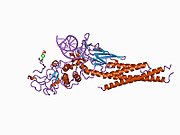STAT3
| View/Edit Human | View/Edit Mouse |
Signal transducer and activator of transcription 3 (STAT3) is a transcription factor which in humans is encoded by the STAT3 gene.[5] It is a member of the STAT protein family.
Function
STAT3 is a member of the
STAT3-deficient mouse embryos cannot develop beyond embryonic day 7, when gastrulation begins.[10] It appears that at these early stages of development, STAT3 activation is required for self-renewal of embryonic stem cells (ESCs). Indeed, LIF, which is supplied to murine ESC cultures to maintain their undifferentiated state, can be omitted if STAT3 is activated through some other means.[11]
STAT3 is essential for the differentiation of the TH17 helper T cells, which have been implicated in a variety of autoimmune diseases.[12] During viral infection, mice lacking STAT3 in T-cells display impairment in the ability to generate T-follicular helper (Tfh) cells and fail to maintain antibody based immunity.[13]
STAT3 caused upregulation in E-selectin, a factor in metastasis of cancers.[14]
Hyperactivation of STAT3 occurs in COVID-19 infection and other viral infections.[15][16]
Clinical significance
Loss-of-function mutations in the STAT3 gene result in hyperimmunoglobulin E syndrome, associated with recurrent infections as well as disordered bone and tooth development.[17]
Gain-of-function mutations in the STAT3 gene have been reported to cause multi-organ early onset auto-immune diseases; such as thyroid disease, diabetes, intestinal inflammation, and low blood counts,[18] while constitutive STAT3 activation is associated with various human cancers and commonly suggests poor prognosis.[19][20][21][22] It has anti-apoptotic as well as proliferative effects.[19]
STAT3 can promote oncogenesis by being constitutively active through various pathways as mentioned elsewhere. A tumor suppressor role of STAT3 has also been reported.[23][24][25] In the report on human glioblastoma tumor, or brain cancer, STAT3 was shown to have an oncogenic or a tumor suppressor role depending upon the mutational background of the tumor. A direct connection between the PTEN-Akt-FOXO axis (suppressive) and the leukemia inhibitory factor receptor beta (LIFRbeta)-STAT3 signaling pathway (oncogenic) was shown.
Increased activity of STAT3 in cancer cells, leads to changes in the function of protein complexes that control expression of inflammatory genes, with result profound change in the secretome and the cell phenotypes, their activity in the tumor, and their capacity for metastasis.[26]
Interactions
STAT3 has been shown to
Niclosamide seems to inhibit the STAT3 signalling pathway.[56]
Nicotinamide (a type of vitamin B3) naturally inhibits STAT3.[57] However NAC (Acetylcysteine) inhibits STAT3 inhibitors.[58]
References
- ^ a b c GRCh38: Ensembl release 89: ENSG00000168610 – Ensembl, May 2017
- ^ a b c GRCm38: Ensembl release 89: ENSMUSG00000004040 – Ensembl, May 2017
- ^ "Human PubMed Reference:". National Center for Biotechnology Information, U.S. National Library of Medicine.
- ^ "Mouse PubMed Reference:". National Center for Biotechnology Information, U.S. National Library of Medicine.
- S2CID 42211976.
- PMID 23329648.
- S2CID 9420068.
- PMID 17216035..
- PMID 15485908. 15485908.
- PMID 9108058.
- PMID 10428964.
- PMID 17277312.
- PMID 25393615.
- PMID 33862151.
- PMID 33037393.)
{{cite journal}}: CS1 maint: multiple names: authors list (link - PMID 32201498.)
{{cite journal}}: CS1 maint: multiple names: authors list (link - PMID 17881746.
- PMID 25359994.
- ^ PMID 16529541.
- PMID 16540667.
- PMID 16603078.
- PMID 16685378.
- PMID 18258752.
- PMID 22496368.
- PMID 19962983.
- PMID 28884042.
- ^ PMID 11751884.
- PMID 11322786.
- PMID 10954736.
- PMID 10205054.
- ^ PMID 15485908.
- PMID 10358079.
- PMID 18985005.
- ^ S2CID 38074766.
- PMID 10490649.
- PMID 11585385.
- S2CID 14181036.
- PMID 15522880.
- PMID 12947115.
- PMID 12867595.
- ^ PMID 12057007.
- PMID 14522952.
- PMID 9388192.
- PMID 11773079.
- PMID 12506013.
- PMID 11021801.
- PMID 12637586.
- PMID 11536047.
- S2CID 23783745.
- PMID 11594781.
- PMID 12070153.
- PMID 28474672.
- PMID 8657134.
- PMID 15163742.
- PMID 15919823.
- PMID 24900231.
- PMID 29980616.)
{{cite journal}}: CS1 maint: multiple names: authors list (link - S2CID 210983316.)
{{cite journal}}: CS1 maint: multiple names: authors list (link
Further reading
- Hoey T, Grusby MJ (1999). STATs as Mediators of Cytokine-Induced Responses. Advances in Immunology. Vol. 71. pp. 145–62. PMID 9917912.
- Kisseleva T, Bhattacharya S, Braunstein J, Schindler CW (February 2002). "Signaling through the JAK/STAT pathway, recent advances and future challenges". Gene. 285 (1–2): 1–24. PMID 12039028.
- Joseph AM, Kumar M, Mitra D (January 2005). "Nef: "necessary and enforcing factor" in HIV infection". Current HIV Research. 3 (1): 87–94. PMID 15638726.
- Inghirami G, Chiarle R, Simmons WJ, Piva R, Schlessinger K, Levy DE (September 2005). "New and old functions of STAT3: a pivotal target for individualized treatment of cancer". Cell Cycle. 4 (9): 1131–3. PMID 16082218.
- Leeman RJ, Lui VW, Grandis JR (March 2006). "STAT3 as a therapeutic target in head and neck cancer". Expert Opinion on Biological Therapy. 6 (3): 231–41. S2CID 3092794.
- Aggarwal BB, Sethi G, Ahn KS, Sandur SK, Pandey MK, Kunnumakkara AB, Sung B, Ichikawa H (December 2006). "Targeting signal-transducer-and-activator-of-transcription-3 for prevention and therapy of cancer: modern target but ancient solution". Annals of the New York Academy of Sciences. 1091 (1): 151–69. S2CID 814675.
- Yu H, Kortylewski M, Pardoll D (January 2007). "Crosstalk between cancer and immune cells: role of STAT3 in the tumour microenvironment". Nature Reviews Immunology. 7 (1): 41–51. S2CID 20191132.

